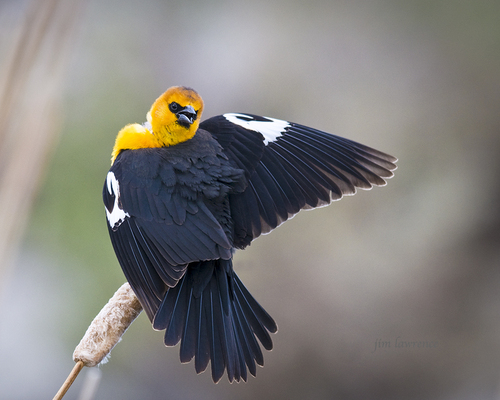
Yellow-headed Blackbird
The Yellow-headed Blackbird (*Xanthocephalus xanthocephalus*) is a striking North American bird species, easily recognized by the male's brilliant yellow head and chest contrasting sharply with its black body. This medium-sized blackbird plays a significant role in wetland ecosystems, primarily as an insectivore during breeding season, helping to control insect populations. It holds cultural significance in some Native American traditions, often associated with marshes and water. It's a highly social species outside the breeding season, forming massive flocks that can number in the thousands.
22-26 cm
Length
39-44 cm
Wingspan
Least Concern
Conservation Status
Distribution
Breeds across western and central North America, from British Columbia and the prairie provinces of Canada south to northern Baja California, Arizona, and New Mexico. Migrates to the southwestern United States and Mexico for winter.
Lifespan
Up to 11 years in the wild, though the average is likely lower.
Yellow-headed Blackbird's Habitat
Habitat Types
Freshwater marshes, Cattail marshes, Tule marshes, Shallow lakes with emergent vegetation
Climate Zones
Temperate, Semi-arid
Adaptations
Their strong legs and feet are well-suited for clinging to reeds and cattails. They exhibit a preference for nesting over water, providing protection from terrestrial predators.
Variations
No recognized subspecies, though slight variations in size and plumage intensity may occur across their range.
Appearance
Breeding Plumage
Breeding males have a bright yellow head and breast, black body, and white wing patches. Females are much duller, with a brownish-gray body and a muted yellow throat and supercilium. Non-breeding males resemble females but retain more yellow.
Seasonal Feather Changes
Males molt into a duller plumage after breeding, losing some of the vibrancy of their yellow coloration.
Sex Based Plumage Differences
Highly pronounced. Males are brightly colored, while females are cryptic and blend in with marsh vegetation.
Notable Features
Bright yellow head and breast (males), White wing patches (males), Sharp, conical bill, Strong legs and feet
Diet and Feeding
Primary Foods
Insects (especially during breeding season), Spiders, Seeds, Aquatic invertebrates, Grain (particularly in winter)
Foraging Behavior
Forages by walking on the ground, gleaning insects from vegetation, or wading in shallow water. They also catch insects in flight. In winter, they often forage in large flocks in agricultural fields.
Specializations
Their slightly decurved bill is versatile, allowing them to probe for insects and consume seeds effectively.
Seasonal Diet Variations
Diet shifts from primarily insects during the breeding season to include more seeds and grains during the winter months when insects are less available.
Behavior
Social Structure
Highly colonial during breeding season, with males defending small territories within a larger colony. Outside of breeding, they form large, mixed-species flocks with other blackbirds.
Communication
Harsh, rasping songs (males), Chattering calls, Visual displays (wing spreading, feather fluffing)
Migration
Migratory, traveling in large flocks. They follow general north-south routes between breeding and wintering grounds.
Territorial or Group Behaviors
Males are highly territorial during breeding, defending their nesting area from rivals. Females may also engage in territorial disputes. Outside of breeding, they are highly gregarious.
Conservation
Threats
Habitat loss (wetland drainage), Pesticide exposure, Climate change (affecting wetland availability and insect populations), Collisions with vehicles and structures
Protection Programs
Wetland conservation and restoration efforts, Migratory Bird Treaty Act protection, Some state-level protections
Local National Laws
Protected under the Migratory Bird Treaty Act in the United States, Canada, and Mexico.
Population Trend
Stable
Population Estimates
Global population estimated at around 16 million.
Interesting Facts
They are polygynous
Males often mate with multiple females within their territory.
They often nest in the same marshes as Red-winged Blackbirds
But Yellow-headed Blackbirds tend to prefer deeper water.
Their scientific name, *Xanthocephalus xanthocephalus*, means 'yellow-headed yellow-head'
A rather redundant, but descriptive, name.
Females sometimes lay eggs in the nests of other birds.
This is known as brood parasitism, and Red-winged Blackbirds are a common host.
Their calls have been described as sounding like a rusty gate hinge.
A distinctive and not particularly melodious sound.
Faqs about Yellow-headed Blackbird
What do Yellow-headed Blackbirds eat?
They eat mostly insects during the breeding season and seeds/grains during the winter. They also consume spiders and aquatic invertebrates.
Where do Yellow-headed Blackbirds live?
They live in freshwater marshes and wetlands across western and central North America.
Are Yellow-headed Blackbirds aggressive?
Males are territorial during the breeding season and will aggressively defend their nesting area. Otherwise, they are generally not aggressive towards humans.
Do Yellow-headed blackbirds migrate?
Yes, they are migratory birds. They breed in central and western North America and migrate to the Southern USA and Mexico.
How can I attract Yellow-headed Blackbirds to my yard?
It is unlikely to attract them to a typical yard. They require marsh habitat. Supporting wetland conservation is the best way to help them.
Copyright @ Nature Style Limited. All Rights Reserved.
 English
English